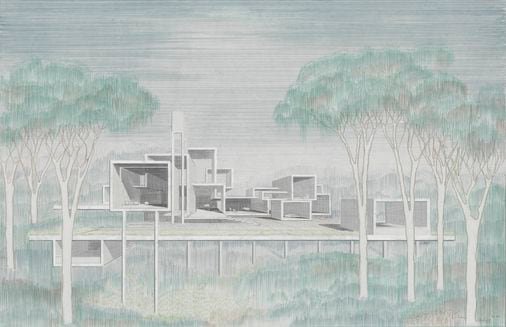The eminence of those names gives a sense of how much this small but arresting show has to offer. There are some 50 items on display, not just artworks but also colored pencils, an airbrush, and exhibition cards for a 1977 exhibition at New York’s Leo Castelli gallery. The MIT show is pretty much an ideal size: small enough for a visitor to comfortably take everything in, big enough to be varied and wide-ranging.
The period in question is from the late ‘70s to late ‘80s, with a few outliers. Those outliers — Louis Kahn (1959), Paul Rudolph (1965), and Gehry (2004) — are further evidence of eminence. Other architects with works in the show include Peter Eisenman, with eight; Stanley Tigerman, with seven; Michael Graves and Jahn, with four each. Jahn took pride in having done more than 100,000 architectural sketches over the course of his career.
One of the Graves drawings is of the Humana Building, in Louisville, Ky. This was one of the signature designs in the emergence of Postmodernism. The reason “Drawing” focuses on the span it does is that it effectively marked the end of Modernism as culturally dominant — not just in architecture — and the arrival of Postmodernism. That’s where the “after” in “Drawing After Modernism” comes in.
The title is a bit of a cheat, albeit in a good way. Rudolph and Kahn aren’t just chronological outliers here, but also stylistic. One can quibble, or even quarrel, over where Late Modernism spills over into Postmodernism. But Rudolph and Kahn remain firmly on the pre-Postmodern side.

Not that there are any complaints about their presence in the show. Rudolph’s exactingly detailed perspective for his Callahan House, in Birmingham, Ala., and Kahn’s sketch for what would become his revered Salk Institute, in La Jolla, Calif., are among the most beautiful drawings in the show. Right up there are Arata Isozaki’s sketch for the Museum of Contemporary Art, in Los Angeles, and two Graves sketches for the San Juan Capistrano, Calif., public library. Both Graveses and the Isozaki were done in graphite and colored pencil and come from 1981.
This period has further significance in that it saw architectural drawings attain a new status. The MIT Museum began collecting them in the mid-’70s. That Castelli show marked the arrival of architectural drawings as a collectible by the art public. In 1978, Max Protetch founded his namesake New York gallery to exhibit architectural drawings. The inaugural Venice Biennale of Architecture took place in 1980.

Coincidence or no, affinities with the visual arts appear throughout the show. It’s more than just that Hadid acrylic. Rem Koolhaas’s gouache and ink on paper for the Villa dall’Ava, outside of Paris, has Edward Hopper lighting. Aldo Rossi’s none-too-serious proposal for a Venetian theater salutes Claes Oldenburg, with its giant Coca-Cola can, tin of Twinings tea, and pack of cigarettes (brand indiscernible). Saul Steinberg would have felt right at home sitting at Tigerman’s drawing table when the architect was coming up with designs for his playful “Architoons” series.
In a different category is James Wise’s never-executed “Highrise of Homes,” a 1981 ink and wash on paper for the firm SITE. It could be a prototype for the piled-up houses in Steven Spielberg’s 2018 film “Ready Player One.”
The clearest indicator of the collectible status that architectural drawings attained is the Gehry lithograph. Visually, it’s an inky scribble of great verve. But the architect never intended its shake-and-bake lines to be translated into three dimensions. He drew them to be sold as a limited-edition print. So, yes, you can own a Frank Gehry, even if you can’t afford to live in one.
The lithograph’s scribble-ness gets at a third transformation in the profession, one posterior to the period covered in the show. By the turn of this century, computer-aided design had become common in architecture. This opened all kinds of new possibilities. Consider MIT’s Stata Center, a Gehry design, that’s a five-minute walk from the museum. It opened in 2004, the same year Gehry did the lithograph. What had for millennia seemed fanciful now became not just possible but executable. Even if not meant as a building design, per se, that scribble was more than just a doodle. Or could have been.
DRAWING AFTER MODERNISM
At MIT Museum, 314 Main St., Cambridge, through Oct. 27. 617-253-5927, mitmuseum.mit.edu
Mark Feeney can be reached at mark.feeney@globe.com.






